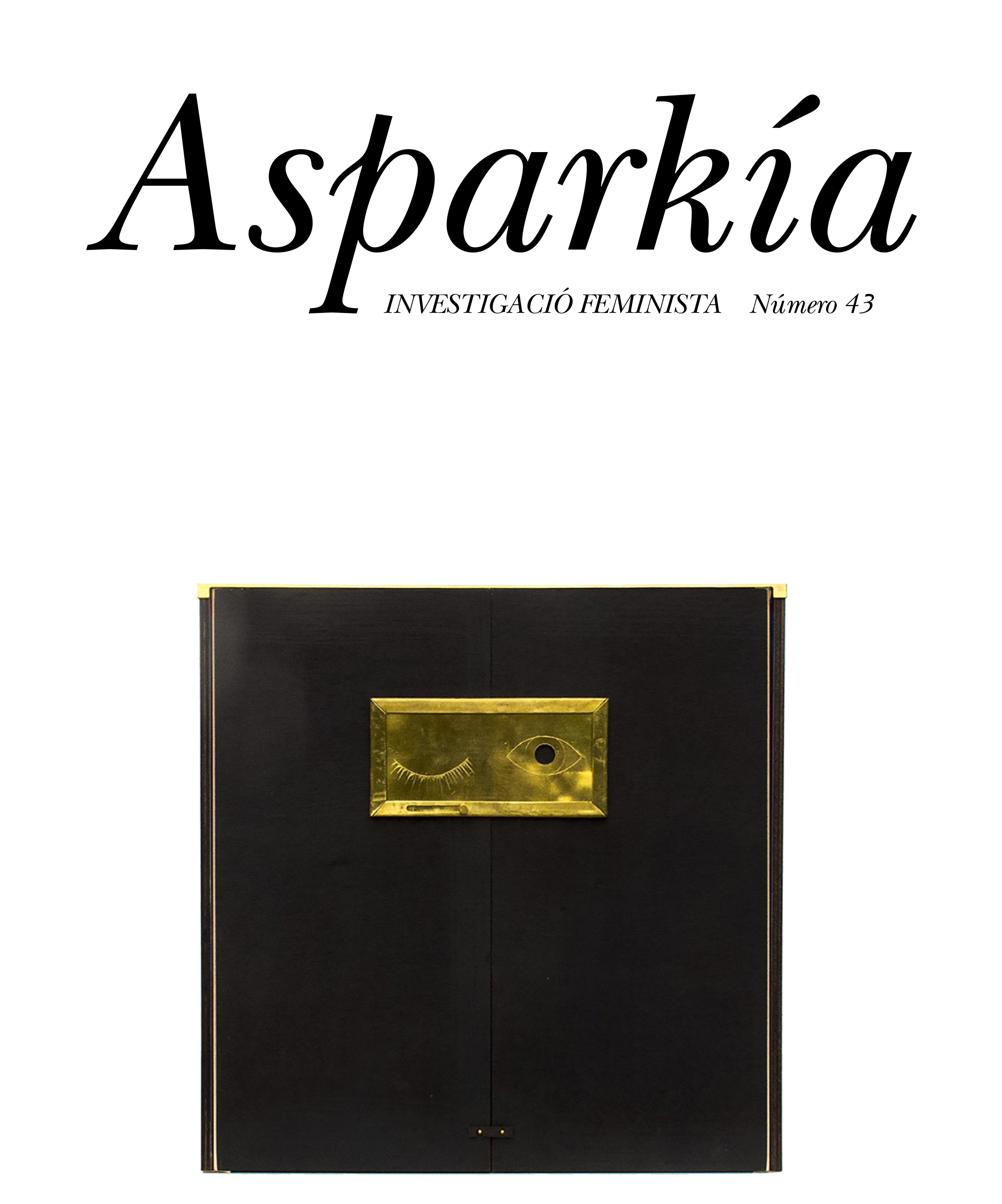Feminismo(s) y espacio: aproximaciones a las artes visuales y a la performance catalana contemporánea
Contenido principal del artículo
Resumen
En este artículo se explora la reconfiguración del espacio, entendido como un lugar donde se imponen valores (hetero)normativos dominantes y se despliegan regímenes visuales, en la obra de tres artistas contemporáneas: Eulàlia Valldosera, Olga Diego y Alicia Framis. El texto sitúa la escena en la Norteamérica de los años sesenta y la emergencia del arte feminista para luego explorar el contexto español y catalán, anotando las reticencias iniciales a su recepción, así como sus huellas invisibles, discontinuidades y ausencias. Se analiza, a continuación, una selección de series fotográficas, instalaciones y performances de estas artistas para mostrar cómo sus intervenciones feministas en el espacio deconstruyen sistemas de poder. Mi análisis se basa en varias teorías feministas, como la noción de la mirada masculina de Laura Mulvey, el análisis sobre la producción del género y la identidad sexual de Paul B. Preciado y las relaciones de género que se establecen en los espacios urbanos de Elisabeth Wilson.
Descargas
Detalles del artículo
Citas
Beuys, Joseph. (1979). Introduction. In Carin Kuoni (Ed.), Energy Plan for the Western Man: Joseph Beuys in America. Basic Books.
Best, Susan. (2007). The Serial Spaces of Ana Mendieta. In Art History, 30:1, 57-82.
Bishop, Clare. (2005). Installation Art. Tate Publishing.
Blocker, Jane. (1999). Where Is Ana Mendieta? Identity, Performativity, and Exile. Duke University Press.
Bondi, Liz and Rose, Damaris. (2003). Constructing gender, constructing the urban: A review of Anglo-American feminist urban geography. In Gender, Place & Culture: A Journal of Feminist Geography, 10:3, 229-245.
Borja-Villel, Manuel and Enguita Mayo, Nuria. (2009). Foreword. In Dependences. (pp. 13-16). Museo Nacional Centro de Arte Reina Sofia.
Bru-Domínguez, Eva. (2019). Embodied Memory: Shadow and Index in Family Ties by Eulàlia Valldosera. In Journal of Romance Studies, 19:2, 261-281.
Bru-Domínguez, Eva. (2014a). Interview with Eulàlia Valldosera. Unpublished.
Bru-Domínguez, Eva. (2014b). Interview with Olga Diego. Unpublished.
Butler, Judith. (1999 [1990]). Gender Trouble. Feminism and the Subversion of Identity. Routledge.
De la Villa, Rocío. (2013). En torno a la generación de los noventa. In Vicente Aliaga, Juan and Mayayo, Patricia (Eds.), Genealogías feministas en el arte español: 1960-2010 (pp. 261-284). This Side Up.
Diego, Olga. (n.d.) https://www.olgadiego.com/p/burbuja.html [access date 15-12-2022].
Diego, Olga. (2011). La artista. Revista Trentaicuatro, (1), 34-35.
Enguita Mayo, Nuria, Marí, Bartomeu and Valldosera, Eulàlia. (2000). Conversation. In Eulàlia Valldosera. Works 1990-2000 (pp. 19-44). Witte de With.
Gasol, Daniel and Valldosera, Eulàlia. (2010). Entrevista a Eulàlia Valldosera – Daniel Gasol. http://salonkritik.net/09-10/2010/06.
Jaén Urban, Gaspar. (2014). Olga Diego y el cuerpo : Autorretratos en un paisaje. In Bru-Dominguez, Eva and Jaén Urban, Gaspar. (Eds.), Olga Diego: Transgressive Arquitecture (pp. 3-8). Departamento de Expresión Gráfica y Cartografía, Universidad de Alicante.
Jones, Amelia. (2012). Seeing Differently: a History and Theory Identification and the Visual Arts. Routledge.
Lanceta, Teresa. (2014) Olga Diego y el Aire. In Bru-Dominguez, Eva and Jaén Urban, Gaspar. (Eds.), Olga Diego: Transgressive Arquitecture (pp. 11-12). Departamento de Expresión Gráfica y Cartografía, Universidad de Alicante.
Lefebvre, Henri. (1991 [1974]). The Production of Space. Blackwell Publishing.
López Páez, Montserrat. (2017). Constructiones y performances: las prendas de Alicia Framis. In Estúdio, artistas sobre oultras obras, 19, 69-78.
Mayayo, Patricia. (2013). Imaginando nuevas genealogías. Una mirada feminista a la historiografía del arte español contemporáneo. In Aliaga, Juan Vicente and Mayayo, Patricia (Eds.), Genealogías feministas en el arte español: 1960-2010 (pp. 19-50). This Side Up.
Marí, Bartomeu (2009). Actions, objects and devices in the oeuvre of Eulalia Valldosera. In Dependences (pp. 105-115). Museo Nacional Centro de Arte Reina Sofía.
Mader, Rachel. (2008). Can Beauty beat Violence ? Alicia Framis, Emmanuelle Antille and Hikaru Miyakawa. In n.paradoxa 21, pp. 76-84. https://www.ktpress.co.uk/nparadoxa-volume-details.asp?volumeid=21
Mulvey, Laura. (1975). Visual Pleasure and Narrative Cinema. In screen, 16 :3, 6-18. https://doi.org/10.1093/screen/16.3.6
Nead, Lynda. (2001). The Female Nude. Art, Obscenity and Sexuality. Routledge.
Plate, Liedeke and Rommes, Els. (2007). SafeCitySpace: women’s interventions in urban and virual space. In Journal of Romance Studies. 7:1, 21-38.
Pollock, Griselda. (1999) Differencing the Cannon: Feminism and the Writing of Art’s Histories. Routledge.
Preciado, Beatriz. (2008). Testo Yonqui. Espasa Libros, S.L.U.
Stratten, Jon. (2015). Playing the Jew: anti-Semitism and football in the twenty-first century. In Jewish Culture and History, 16 :3, 293-311.
Ukeles, Mierle Laderman. (1969). Manifesto! Maintenance Art. Proposal for an Exhibition. ‘CARE’ https://queensmuseum.org/wp-content/uploads/2016/04/Ukeles-Manifesto-for-Maintenance-Art-1969.pdf.
Villaespesa, Mar. (2009). Interrupt our calculations and begin again at zero. In Dependences (pp. 116-137). Museo Nacional Centro de Arte Reina Sofía.
Wilson, Elisabeth. (1992). The Sphinx in the City. University of California Press.


